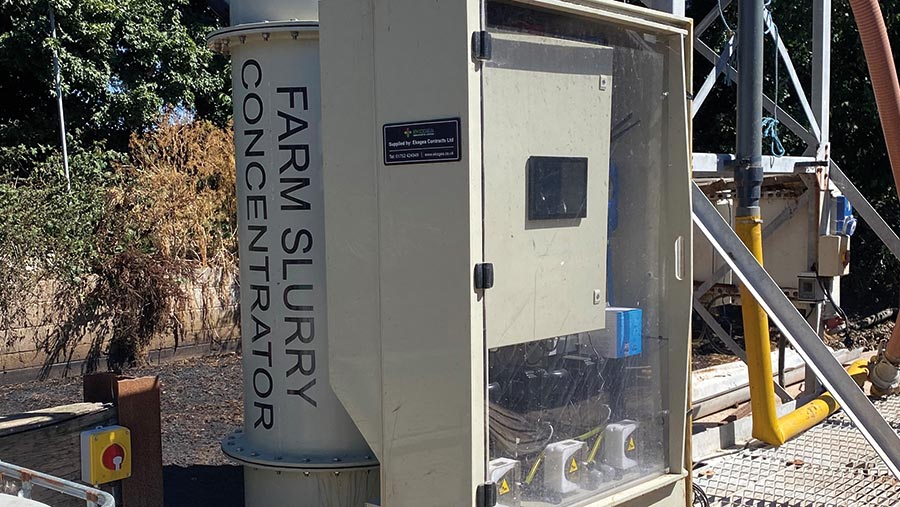New slurry concentrator has huge potential for stock farmers
 © Ekogea
© Ekogea Scientists from Ekogea have unearthed the powers of a type of marine algae and seaweed only found in the North Atlantic ocean.
Named ascophyllum nodosum, the seaweed is sustainably harvested from the Isle of Lewis in the Outer Hebrides.
It has been developed into a product named BioComplex, which serves a biological enhancer used to accelerate processes from plant root growth, through to improving animal gut health.
See also: Thompson Brothers’ bespoke umbilical slurry pumping trailer
Its latest application is within Ekogea’s sustainable farm slurry management system, which is capable of removing up to 85% of the water volume from pig and dairy slurry, and cleaning extracted water for reuse or discharge to sewers and waterways.
How does it work?
The process begins with raw slurry from either pigs or dairy cattle, which is typically pumped from their housing to a standard separator or screw press to remove the worst of the fibres larger than 250μm (microns).
The solids extracted usually equate to about 5% of the slurry’s original volume, while the separated liquid slurry, which makes up the remaining 95%, is pumped to the concentrator to undergo further processing.
“The concentrator has a very special process that manages to persuade just the solids to come out of the top of the machine, and for the liquids to remain at the bottom,” says director Ian Cain.
“This involves a lot of stirring, resting, and aeration.”
The process removes 80-85% of the slurry’s water content, producing a “solid” material that still retains much of its original nutrient value – including phosphorous, potassium and nitrogen – but with just 15% of its original volume.
“Being able to de-water in this way is really effective,” says Mr Cain. “You don’t lose too much of the valuable fertiliser content into the water itself, but retain it in the ‘solids’ for spreading to the land as a fertiliser.”
How does the seaweed come into this?
One significant benefit of the BioComplex additive is that it has cation-exchange capacity.
This means that it is able to change the structure of certain molecules, such as hydrogen sulfide and ammonia, within the slurry.
The atoms move from the ammonia and hydrogen sulfide, and become ammonium, which is a nitrate, and elemental sulfur – both of which are more plant available and less likely to be lost as gases.
So, when the BioComplex is added to the slurry concentrator, or even fed to livestock to interact with the gut of the animal, more of the resulting ammonia and hydrogen sulfide is moved into a solid state.
This means that, during the de-watering process, the concentrated slurry is left with more nitrogen and therefore more fertiliser value within the spreadable solids.
At this stage, two further treatments can be applied. The first is an additional de-watering and drying system that turns the slurry into a dry, stackable, solid material.
This does away with the need for lagoon storage, and the end product can be bagged and sold as commercial fertiliser, or applied straight to the field.
The second treatment is carried out using Ekogea’s H2E system, which uses the BioComplex to treat the grey water that still contains much of the slurry’s ammonia.
This takes place within a simple, compact 20x30ft processing plant, using the seaweed additive to naturally accelerate the waste water treatment.
The end result is almost pure water, stripped of its ammonia content and deemed clean by Environmental Agency standards, so it can be discharged to sewers or rivers under permit, or used on the farm for wash-down or watering.
What are the benefits?
When combined with the solids from the screw press, the concentrated slurry has a higher commercial value.
Being a fraction of its original post-concentration volume, it still retains the majority of its potential yield as a waste feedstock for biogas plants, but with significantly lower transport costs.
The concentrated slurry should produce nine times more biogas a tonne when compared with traditional slurry, making it an attractive asset or additional income stream for farmers to sell to anaerobic digestion plants.
“Not only is it a practical solution because there’s less volume, less pollution, and less storage and transport costs, but we actually also end up with a better-quality fertiliser because more of the nitrogen has been captured and doesn’t just disappear as a gas into the atmosphere,” says Mr Cain.
The entry-level system comes with a price tag of £80,000 – though the cost will depend on size, processing requirements and any additional features requested.
Further ongoing operational costs should also be factored in, including use of BioComplex.

